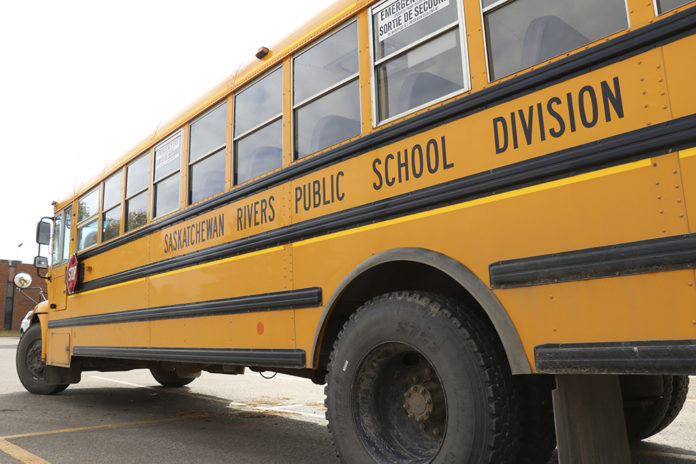The updated return-to-class plan for the Saskatchewan Rivers School division includes the promised mask policy as well as a temporary moratorium on all in-person extracurricular activities.
The division released its updated plan Monday evening. The 52-page document includes guides and guidelines for everything from kindergarten to arts and physical education.
The plan, the division wrote, “will evolve as required.”
The document itself said it is “expected to be a living document that will be revised and enhances as more information becomes available and the circumstances related to COVID-19 change.”
The plan was built off the division’s previous release, a 14-page document outlining the basic return to classroom procedures drafted in early August. The document’s many changes and additions were highlighted in yellow.
Like other school divisions, Sask. Rivers is working to ensure that students remain with the same cohort as much as possible. For elementary schools, that means students will be cohorted with their classrooms.
Lunches, recess and other breaks will be staggered to limit the number of students moving around at any given time.
Lunches, recess and other breaks will be staggered to limit the number of students moving around at any given time.
The division is also sticking to its staggered start plan, though the dates have been adjusted since the province announced a week’s delay before students are allowed back.
Now, half of each class will attend on Sept. 8 and 10, with the other half attending Sept. 9 and 11 before the full return on Sept. 14.
In kindergarten and pre-kindergarten settings, that staggered start is extended.
Classes with under 16 kids will stagger for the first two weeks, while programs with over 20 kids will stagger until Sept. 25. Pre-kindergarten programs will have staggered attendance for all of September.
The staggered return is designed to familiarize students with new COVID-19 protocols and procedures before jumping into full instruction.
All students in Grades 4-12 and all staff will be expected to wear a non-medical mask. While people are welcome to bring their own, the school division will supply disposable masks and, when they become available, two reusable, washable masks per student.
In addition to masks, face shields will be permitted “when there are specific requirements and when medical or safety concerns exist,” the division wrote.
While that mask policy applies only to non-medical face coverings, the division said that anyone who volunteers to wear any PPE is welcome to do so.
Masks will be required at school, including outside if physical distancing of 2 metres cannot be maintained. They’ll also be required on the school bus. Exceptions are when distancing can be maintained outside, in aquatics or band class, or accommodations for verified medical restrictions.
The document advised parents to “prepare students for wearing a mask during the school day (by having) children wear a non-medical grade mast at home for durations of time prior to return to school.”
Masks are not required for students in pre-kindergarten to Grade 3, though they can be worn if desired.
When it comes to hand-washing, the division said that each time anyone enters a classroom, it’s expected that they use sanitizer to clean their hands.
All in-person extracurricular activities are suspended until further notice. Extra-curricular plans will be developed once the startup has been reviewed and evaluated, the division said.
Additionally, no new third-party or community use of schools will be allowed. Existing partnerships can continue so long as health guidelines such as masking and hand sanitizing are followed.
Other guidelines aimed at school use and students include:
Minimizing materials or assignments coming back to school, aside from digital sharing of documents
Leaving it open to schools to close ‘non-essential’ food services such as canteens
Leaving returned materials out for 72 hours before handling,
Schools to determine locker use and access, with students only allowed to touch their assigned locker
All assemblies are postponed until further notice
Other guidelines were aimed at staff members. They include:
Mandating masks or face shields for bus drivers
Instructing staff members to keep their workstations and classrooms clean and tidy
Mandating that anyone who carpools wear a mask and limiting carpools to two people per car
Encouraging teachers to prepare and plan two weeks in advance to minimize any potential effects of a two-week self-isolation.
There will be no limit to how many locations a substitute teacher can be booked, but any itinerant staff will need to check-in when they arrive at a school
Different itinerant staff have different guidelines for how many schools they can work at and how.
The Kindergarten and pre-kindergarten return will also look a little bit different. The province has said before that social distancing is harder in younger children. Instead, the focus is on keeping them from touching each other.
The section on kindergarten included instructions to avoid using cloth lunch bags and recyclable containers, using paper bags and disposable wrap instead. It also included guidelines for educators to “create spaces that surround the children with hope and possibility, inspire innovation and curiosity … Strive to maintain a home-like, cozy, safe and culturally-response environment, and to “see the complexity of simplicity,” among other suggestions.
The guidelines also said children will be instructed to avoid putting toys or other materials in their mouths.


